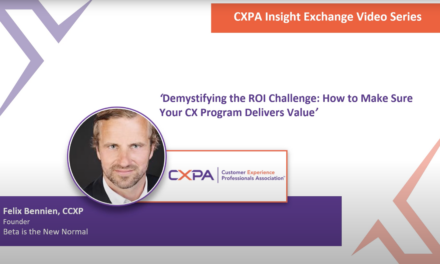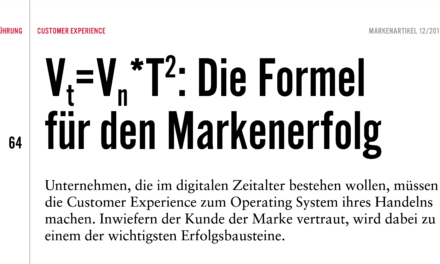When company managers, consultants and agencies talk about customer experience, they often mean completely different things. The following glossary is intended to help in finding a common language:
Customer Experience // The sum of all interactions of a customer with a company or a brand over time – shapes the customer’s overarching perception – usually takes place continuously and is not static – each new interaction becomes part of the overarching customer experience.
Customer end-to-end or macro journey // The typical sequence of interactions that a customer goes through – from identifying a need, through the information and purchase process, to the use of a product/service and, if necessary, its repurchase/cancellation
Customer micro-journey or use case // A self-contained partial sequence of interactions with a clear beginning and end (sub-journey) – Section of the overarching customer journey (e.g. a product test, receipt of goods, payment of an invoice, etc.) – Use cases describe the same sub-journey from the customer’s perspective and are usually formulated in the first-person perspective (“I would like to find a new smartphone.”, “I would like to buy product X.”, “I have to pay my bill.”)
Customer touchpoint // A single point of interaction between customer and company on the customer journey (e.g. surfing the company website, reading a product description, calling a sales representative or call center) – the customer journey results from the sum of all interaction points – many contact or interaction points can be designed by the company itself, others cannot (e.g. security check at the airport from the perspective of an airline)
Micro Moments or Nano Journey // A single moment (or series of moments) during the use of a touchpoint that is decisive for the perception of the respective interaction (e.g. the moment when the sales representative names the price of the product solution or the moment when the buyer clicks on ‘Buy’ on the Internet) – Micro Moments can influence the entire perception of the customer experience
Pain point // A touchpoint or micro-moment that frustrates the customer and negatively influences their overarching perception of the interaction (e.g. an employee is unfriendly, the ordered goods do not arrive on time, the ATM ‘swallows’ the debit card, the product does not work as desired with other technical devices, etc.).
Moment of Truth // A touchpoint or interaction that is of great importance to the customer and represents a ‘moment of truth’ for them (e.g.: the service technician arrives within 2 hours in winter when the heating has broken down and can fix the problem directly on site, withdrawing money from a foreign ATM on vacation, paying smoothly with a credit card in a restaurant, etc.).
Un-met Need // A previously unaddressed need that a customer would like to have satisfied, but which has not yet been solved by any provider – usually offers great potential for innovation and additional value creation – e.g. Uber has understood that cab customers are looking for a simple and reliable form of ordering and do not want to worry about payment
Occasion-based Need States // Describes different needs of the same customer based on the current situation they are in (e.g.: a can of chilled cola on a hot day by the sea vs. a crate of 2l bottles for a child’s birthday party, an express delivery due to a forgotten birthday vs. satisfaction with 2-3 days delivery time for normal orders, etc.).
Customer Listening // The sum of all market research activities to understand the customer experience, customer journey, needs, expectations, buying behavior, product and service usage, satisfaction and loyalty of customers – can be quantitative and qualitative as well as external and internal – generated through primary and secondary market research, media usage, click-through rates, behavioral data, sales data, product usage data, etc.
Data Analytics & Management Platform // A data management platform (DMP) that is able to merge heterogeneous data sets, analyze them and integrate them in terms of meaningful relationships and statements – from which (new) customer insights can be derived
Customer Insights // Valuable insights into actual, previously unknown or misinterpreted customer needs as a result of the aggregation and analysis of data – customer data from customer listening is increasingly serving as input for this, in addition to traditional observation
Customer segment // A clearly describable group of customers who share the same needs, expectations or behavioral patterns and can be clearly distinguished from other customer groups – is used to offer this customer group specific messages, channels and solutions that are beneficial to them
Customer persona // The ‘human’ description of a typical customer segment using a fictitious person – builds on psychological dimensions such as attitude and needs rather than product usage, sales data and other facts (but can also be supplemented with these) – usually makes the description of a customer segment more ‘tangible’ for the user, as a real person can be imagined
Content management platform/system // A technical marketing tool to control the creation, individualization and distribution of messages and other content (images, videos, etc.) to different customer segments – enables efficient (partial) automation of communication with a growing number of customer segments – helps to counter the growing complexity due to increasing granularity of customer segments
Marketing Technology // A group of different tools or an integrated solution to integrate the entire marketing process on one technical platform – starting with customer listening and segmentation, through the creation and management of content, to the management of channels and playout – integrates the entire customer relationship management – a booming industry in which no provider has yet managed to optimally integrate all facets and thus set a ‘gold standard’
CX Business Ecosystem // The other side of the coin: Does the customer journey reflect the sum of the resources (employees, processes, systems and technologies) that enable or provide each individual touchpoint along the customer journey from the company’s perspective – without a deep understanding of the processes underlying the customer journey in the company, it is not possible to optimize the customer experience and make the necessary changes to the operating model
CX Management // A data-based approach to holistic customer experience management based on three pillars: (1) provision and use of data and customer insights derived from customer listening throughout the company, (2) continuous optimization and innovation of the customer experience based on segment-specific customer journeys, and (3) establishment and ongoing strengthening of a customer-centric culture within the company while continuously optimizing employee experience and journeys
CX Management Platform // Analogous to Marketing Technology: A group of different tools or an integrated solution to link the knowledge acquired through customer listening about the behavior, needs and expectations of customers with the business ecosystem and the procedures and processes laid out therein – makes it possible to break down complexity and achieve effective and efficient customer experience management in the first place
CX Value Creation // The analytically proven link between improvements in the customer experience and the value creation achieved for customers and companies – increasing customer satisfaction and loyalty AND employee loyalty, as well as achieved sales increases and cost reductions as a contribution to the overall success of the company





